 To enhance service speed and avoid tariff delays, we've opened a US warehouse. All US orders ship directly from our US facility.
To enhance service speed and avoid tariff delays, we've opened a US warehouse. All US orders ship directly from our US facility.
| Cat. No. | Product Name | Field of Application | Chemical Structure |
|---|---|---|---|
| DC60362 | DLenDMA |
DlenDMA is a lipid for RNA and vaccine delivery. DLenDMA showed better siRNA transfection efficiency than DODMA.
More description
|

|
| DC60421 | DC-6-14 |
DC-6-14 is a cationic lipid that can be used for drug delivery, gene transfection and vaccine delivery. DC-6-14 may be used for research into in vitro and in vivo nucleic acid and protein delivery. Reagent grade, for research use only.
More description
|
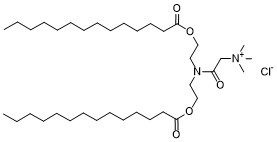
|
| DC65001 | 4A3-Cit |
4A3-Cit is an ionizable lipid used for the generation of lipid nanoparticles (LNPs). To investigate the role of unsaturated lipid tails in iLNPs, the
nucleophilic amines were added to ester-based linkers, followed
by Michael’s addition to the thiols to construct a library of 91
amino ionizable lipids. Such ionizable lipids were composed
of an ionizable tertiary amine core, an ester-based degradable
linker, and an alkylthiol tail periphery. Through in vitro
and in vivo screening, the iLNPs with 4A3 core and citronellolbased
(Cit) periphery can significantly increase endosome escape
and delivery efficiency of mRNA, leading to 18-fold increase in
protein expression compared with iLNPs without Cit periphery.
Furthermore, the delivery efficiency of mRNA may be associated
with the location/configuration of the unsaturated bond(s) in
lipids. Although lipids with Cit periphery showed excellent
membrane fusion ability to facilitate endosome escape, the
fusion mechanism needs to be further clarified.
More description
|
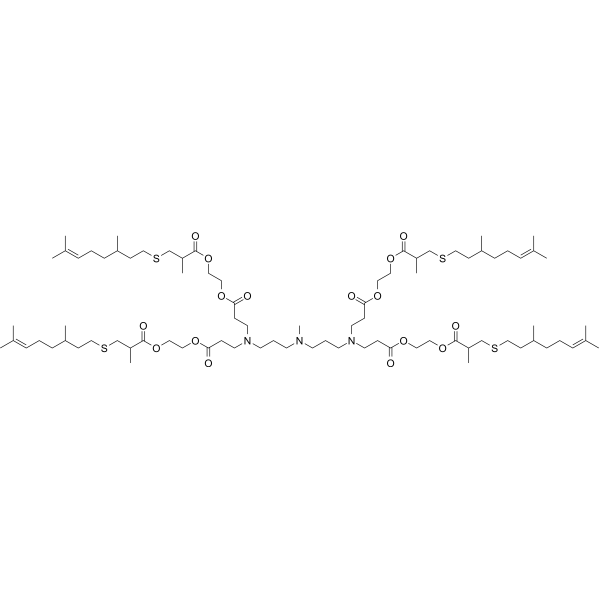
|
| DC60433 | DOBAQ |
DOBAQ, N-(4-carboxybenzyl)-N,N-dimethyl-2,3-bis(oleoyloxy)propan-1-aminium, is a cationic lipids with a quaternary amine and unsaturated hydrocarbon chains. DOBAQ also serves as a pH-sensitive transfection reagent. Reagent grade, for research use only.
More description
|
.jpg)
|
| DC65333 | A2-Iso5-4DC19 |
A2-Iso5-4DC19 is a lipidoid compound. A2-Iso5-4DC19 is an effective carrier for the delivery of an agent such as a polynucleotide to a cell.
More description
|
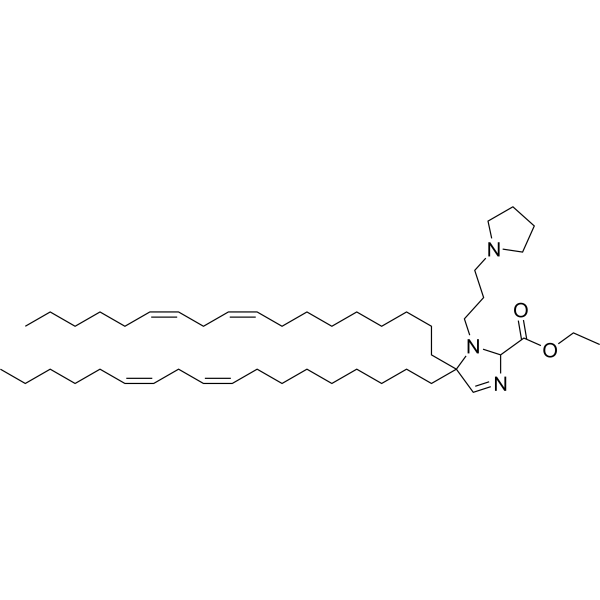
|
| DC65335 | LNP Lipid-5 |
LNP Lipid-5 (Compound Lipid 2) is an ionizable lipid (amino lipid). LNP Lipid-5 can be used to prepare lipid nanoparticles .
More description
|
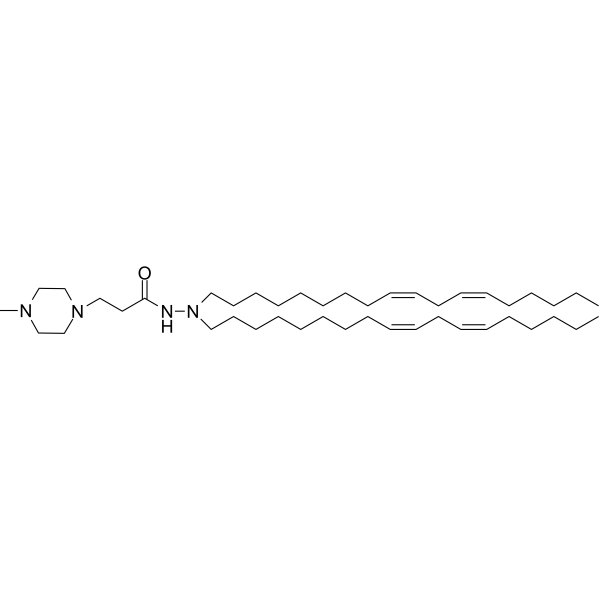
|
| DC65438 | SM-102 Analog 2(Compound 8-8) |
SM-102 Analog 2(Compound 8-8) is a lipid compound. SM-102 Analog 2(Compound 8-8) is involved in the synthesis of lipid nanoparticles compositions. SM-102 Analog 2(Compound 8-8) has potential applications in the transportation of biologically active substances.
More description
|
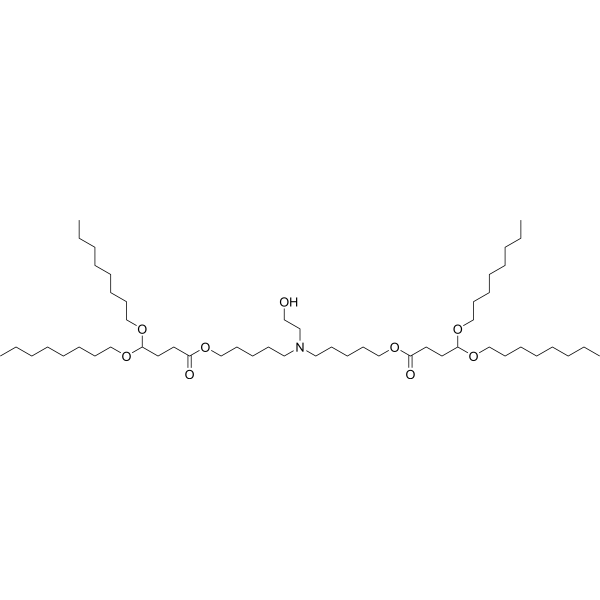
|
| DC65437 | LNP Lipid-2 |
LNP Lipid-2 is a lipid product can be used to deliver agents.
More description
|
|
| DC65439 | LNP Lipid-6 |
LNP Lipid-6 (Compound Lipid 5) is an ionizable lipid (amino lipid). LNP Lipid-6 can be used to prepare lipid nanoparticles (LNP).
More description
|
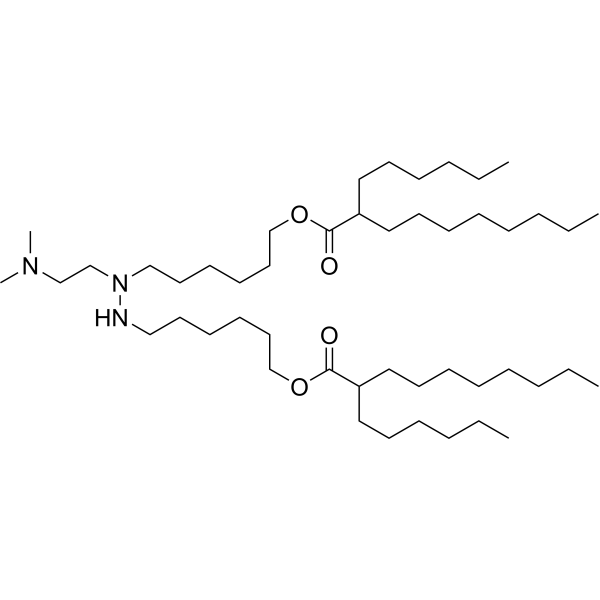
|
| DC60492 | 244cis |
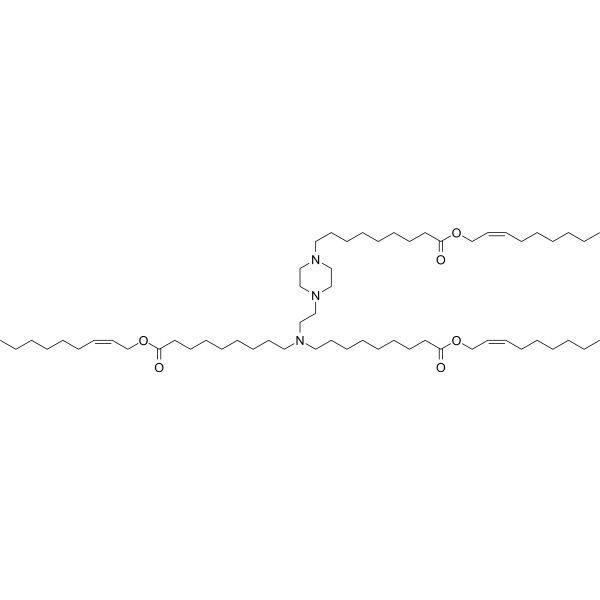
|
|
| DC65623 | Lipid AX4 |
Lipid AX4 is an ionizable cationic lipid (pKa = 6.89) that has been used in the formation of lipid nanoparticles (LNPs) for the delivery of mRNA in vivo.
More description
|

|
| DC65622 | 306Oi9-cis2 |
306Oi9-cis2 is an ionizable cationic lipid.
WARNING This product is not for human or veterinary use.
More description
|

|
| DC65620 | cKK-E15 |
cKK-E15 is an ionizable cationic lipid and a derivative of cKK-E12 that has been used in the generation of lipid nanoparticles (LNPs).1 LNPs containing cKK-E15 and encapsulating Cre mRNA induce the expression of Cre in Kupffer cells, endothelial cells, and hepatocytes in Ai14 mice engineered to express the fluorescent protein tdTomato upon translation of Cre.
More description
|

|
| DC65851 | CL15F6 |
CL15F6 is an ionizable cationic lipid (pKa = 6.75).1 It has been used in the formation of lipid nanoparticles (LNPs) for the delivery of mRNA and polymer-lipid hybrid nanoparticles for the delivery of plasmid DNA in vitro.1,2
More description
|

|
| DC66288 | DOSPA |
DOSPA is a cationicliposome. DOSPA can formulate with DNA to be a transfection system. DOSPA can be used for gene therapy research.
More description
|
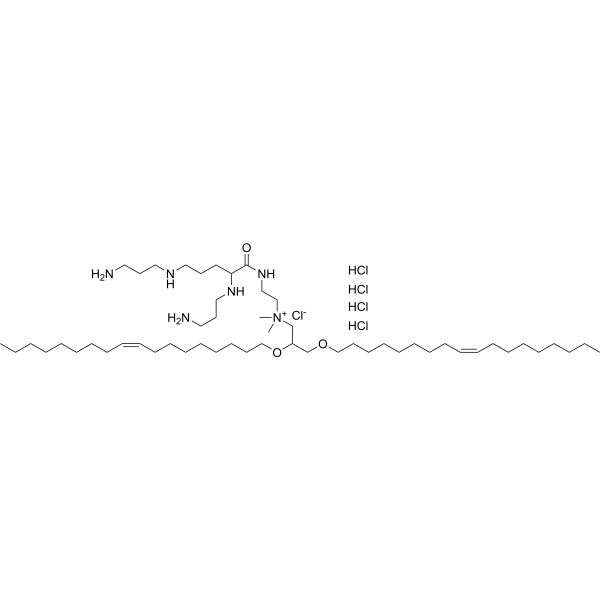
|
| DC66648 | CP-LC-1143 |
Lipid CP-LC-1143 is an ionizable cationic amino lipid derived from homocysteine, a naturally occurring amino acid. This lipid has demonstrated an efficient delivery and high protein expression of different kinds of RNA (mRNA, cRNA and saRNA) in vivo, with no signs of toxicity.
More description
|

|
| DC67117 | 113-N16B |
113-N16B is an ionizable cationic lipid used for the generation of lipid nanoparticles (LNPs). 113-N16B delivers mRNA preferentially to pulmonary endothelial cells.
More description
|
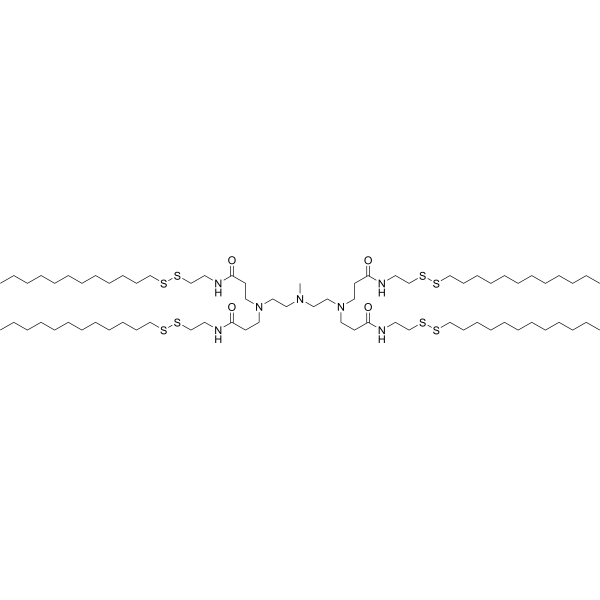
|
| DC48291 | ATX-002 |
ATX-002 is a property-tunable lipid for RNA drug delivery.
More description
|

|
| DC52028 | MVL5 |
MVL5 is a new Multivalent Cationic Lipid for siRNA Delivery.Improved total gene silencing and Lower non-specific gene silencing,Lower toxicity.
More description
|
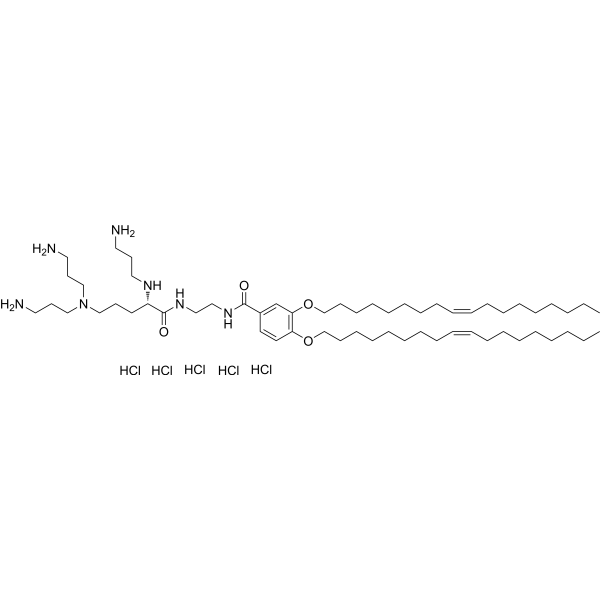
|
| DC49845 | TT3 |
TT3 is an ionizable cationic amino lipid that has been used in combination with other lipids in the formation of lipid-like nanoparticles (LLNs). Administration of LLNs containing TT3 and encapsulating mRNA encoding human coagulation Factor IX induces human coagulation Factor IX expression in the plasma of mice.
More description
|
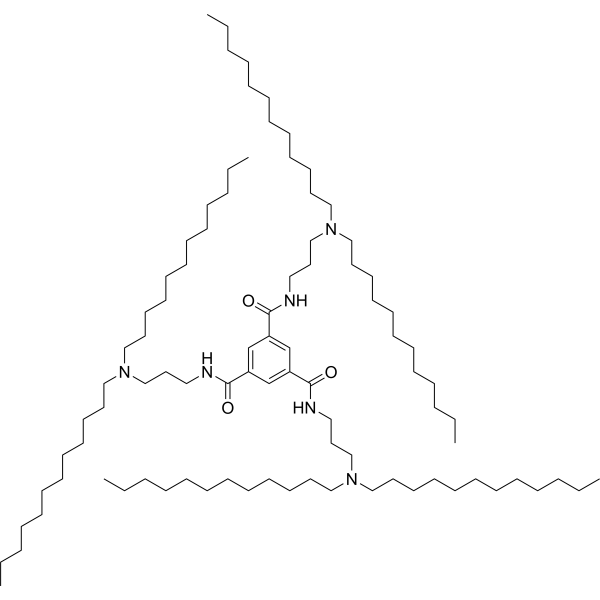
|
| DC67322 | GL67 pentahydrochloride |
GL67 (N4-Spermine cholesteryl carbamate) in its pentahydrochloride form is a cationic lipid with versatile applications in the delivery of nucleic acid agents, vaccines, and gene transfection, owing to its efficient encapsulation and transport capabilities.GL67 (N4-Spermine cholesteryl carbamate) in its pentahydrochloride form is a cationic lipid with versatile applications in the delivery of nucleic acid agents, vaccines, and gene transfection, owing to its efficient encapsulation and transport capabilities.
More description
|
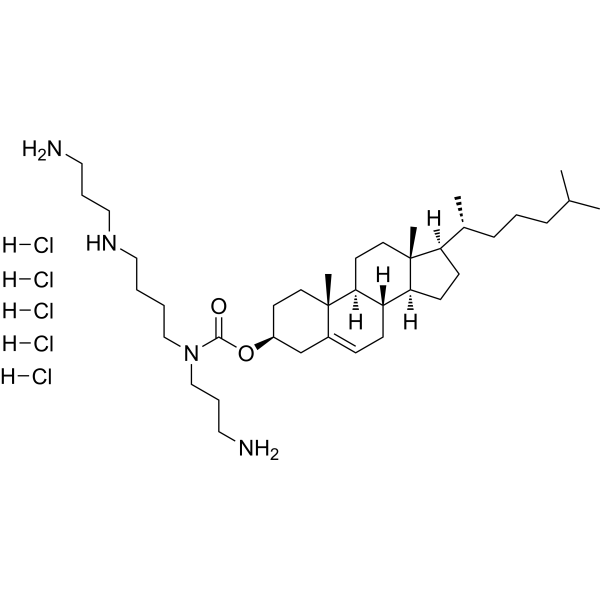
|
| DC60431 | DODAC |
Dioleyldimethylammonium chloride (DODAC) is a cationic lipid that can be used as transfection reagent.
More description
|

|
| DC67449 | Lipid TG4C |
TG4C is an ionizable cationic lipid (pKa 6.71) optimized for mRNA delivery via lipid nanoparticles (LNPs). When formulated into LNPs carrying human EPO mRNA, it significantly elevates serum EPO levels in mice. Furthermore, aerosolized TG4C-based LNPs containing HGF mRNA demonstrate therapeutic potential in pulmonary emphysema models, showing reduced inflammatory cytokines (IL-1β, IL-6, TNF-α) in bronchoalveolar lavage fluid after elastase-induced lung injury.
More description
|

|
| DC67451 | 9C-SCC-10 |
9C-SCC-10 is a biodegradable ionizable lipid (pKa 6.42) with a unique crown-like structure, designed for hepatic mRNA delivery. When formulated into lipid nanoparticles (LNPs), it demonstrates selective liver accumulation in murine models, making it particularly suitable for liver-targeted therapeutic applications.
More description
|

|
| DC60702 | 31hP |
31hP is an asymmetric A3-lipid for mRNA delivery. 31hP LNP exhibits higher stability and durability compared with MC3 LNP and SM-102 LNP. 31hP LNP achieves more efficient hepatic mRNA delivery with a much higher gene editing efficiency than MC3 LNP and LP01 LNP.
More description
|

|
| DC67453 | Lipid 114 |
Lipid 114 (pKa ~6.8) is an ionizable cationic lipid optimized for siRNA delivery via LNPs, demonstrating predominant hepatic accumulation with secondary renal uptake in murine models. When formulated with IL-1β-targeting siRNA, these LNPs effectively suppress pro-inflammatory cytokine expression in both macrophage cell lines and primary cells in a dose-dependent manner. In LPS/galactosamine-induced acute liver failure models, the therapeutic LNPs significantly reduce IL-1β levels in target organs while attenuating hepatic inflammation and injury markers.
More description
|

|
| DC67454 | BCP-NC2-C12 |
BCP-NC2-C12 is an ionizable cationic lipid designed for mRNA delivery, forming LNPs that predominantly localize to hepatic and splenic tissues in vivo. When formulated with CRISPR-Cas9 components (Cas9 mRNA and Pcsk9-targeting sgRNA), these LNPs effectively generate gene-editing indels and significantly lower circulating PCSK9 levels in murine models.
More description
|

|
| DC67457 | Lipid 1 HG3 |
Lipid 1 HG3 serves as a key component in LNPs specifically engineered for in vivo delivery of closed-end DNA (ceDNA), demonstrating efficient nucleic acid encapsulation and targeted release capabilities.
More description
|

|
| DC67456 | Lipid U 105 |
Lipid U 105 is an ionizable cationic lipid (pKa 6.65) specifically designed for circular RNA delivery via LNPs. These formulations effectively enhance VEGF-A expression in HUVECs, promoting endothelial cell proliferation and migration. When applied topically in diabetic mouse models, the VEGF-A-encoding circular RNA LNPs significantly accelerate wound healing, demonstrating therapeutic potential for impaired tissue repair.
More description
|

|
| DC67459 | Lipid A |
Lipid A represents a modified variant of ALC-0315, functioning as an ionizable cationic lipid with a pKa of 4.67 for optimized nucleic acid delivery applications.
More description
|

|